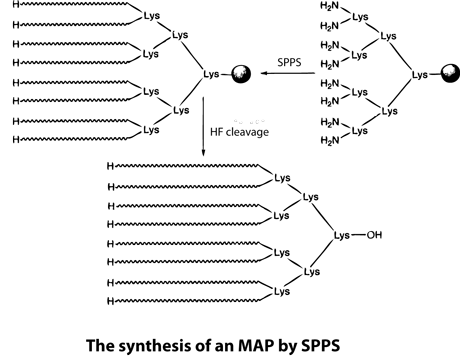LifeTein Peptide Modifications: Multiple Antigenic Peptides
Introducing Multiple Antigenetic Peptide Oligonucleotide Conjugate. Click here for more details.

Multiple Antigenic Peptides (MAPs) are peptides that are branched artificially, in which Lys residues are used as the scaffolding core to support the formation ≤8 branches with varying or the same peptide sequences. Multiple Antigen Peptides have been used to produce antibodies for use in immunological studies. MAPs have a high molar ratio of the peptide antigen to the core molecule, and no carrier protein is needed to elicit an antibody response.
Some native peptides render naturally low immunological responses. However, concentrating such peptides in branched forms increases the immunological response dramatically when they are injected into animals. Generally, an immunogen sized ≥10,000 Da is required. In addition, use of the four-branch MAP resin is recommended for peptides that contain >20 residues, whereas an eight-branch MAP resin is recommended for those with ≤15 residues.
Standard SPSS can be used to synthesize MAPs. This process involves anchoring Boc-Lys(Boc)-OH to a resin, followed by the sequential treatment with TFA, deprotection, coupling, and deprotection cycles. The peptides to be used in immunological studies are then synthesized on each branch.
There are no known branched proteins in nature. However, the synthesis of MAP can be problematic. The strict spacing between each of the eight branches might lead to aggregation of the peptides on the resin, and could result in low coupling yields and peptide deletions.
The PeptideSyn technology used by LifeTein overcomes this problem using a chemical ligation strategy, which allows production of the desired peptide dendrimer at an increased yield. The branched structures could then form an increased molecular weight protein to elicit an immunogenic response.


MAP vs. a peptide with a carrier protein
- Four or eight copies of peptide are synthesized on a branched lysine; therefore, MAP peptides perform like large proteins.
- MAP peptides are injected directly with an adjuvant for antibody production; no carrier protein is required.
- The MAP technique favors N-terminal or internal peptides because the peptide is linked through the C-terminus. In contrast, KLH-conjugation favors C-terminal peptides. However, the KLH carrier might cause steric hindrance.
- MAP peptides might result in a slightly higher titer than KLH-conjugated peptides due to their structure. The MAP design maximizes the antigen concentration because the synthesized peptide-antigen accounts for up to 95% of the total weight of the final product.
- With MAPs, a known amount of peptide can be used for immunization each time, giving greater control over the experimental conditions.
Please click here to get a peptide synthesis service quote now!
